SEO
What Is Enterprise Content Marketing? Strategies You Need To Be Successful

Enterprise content marketing involves creating and sharing relevant content to attract, engage, and retain an organization’s target audience.
When enterprise content marketing is done well, it can drive tons of leads, conversions, and, ultimately, revenue. In addition, it can help with things like brand perception and awareness.
There’s a misconception that big enterprise websites rank for everything. They definitely have an advantage, but they still have to figure out what content to create and put in the work to rank.
Even with all the advantages that enterprise companies have related to the strength of their domain, as well as personnel and resources, they struggle to use SEO effectively to get more traffic.
Scale, complexity, politics, lack of strategy, lack of processes, and red tape make content marketing for enterprise companies more difficult than it is for smaller companies.
Here’s how to approach enterprise content marketing.
When starting out, you may not have any additional resources, funding, or even the personnel you need. You might have to bootstrap a program and even write the content yourself.
That’s okay! The point is to make progress. Don’t let perfect be the enemy of good.
Personnel & resources
If you can at least get together a base team of an SEO, a writer, and an editor, then the process will be smoother. Also, try to have some folks with domain knowledge that you can interview before writing the content or have them review the content so you have expert insights.
As you make progress, you will get more resources and fill in more gaps. Eventually, you’ll probably have more writers, SEOs, editors, project managers, designers, content strategists, and developer resources. In my experience, it’s often easier and cheaper to bring in external resources as you’re scaling than it is to bring in someone in someone for a full-time role.
You’ll also want to make sure that your team has access to any enterprise SEO tools they need to be successful, like Ahrefs.
Have a place to publish your content
The main thing you need to do is make progress, and that means that content should be in a place that’s easy for you and your team to publish. A blog is where most people will start. If you have to have a bunch of custom design work or developers to create every page, it’s going to be hard to make progress.
Making your content marketing successful takes a lot of work. Here are some things you can do.
Create new content
There are many different types of content you can create, but with limited resources, it’s usually best to start out with informational content and videos since they provide high ROI. After you’ve got more resources, you can create things like virtual events, courses, e-books, case studies, white papers, podcasts, or even magazines or books.
The sales process for enterprise companies is typically longer. Many companies want to skip top-of-the-funnel and informational content and focus more on the end-of-funnel traffic that converts. In doing so, they narrow their pipeline and give their competitors opportunities to be seen as experts instead of them.
Starting with bottom-of-the-funnel content makes sense, but eventually, you’ll want to create that top-of-the-funnel content and expand your pipeline.
When creating content, you have to find a process that works best for your company and content creators. That will change depending on who is creating your content.
What content should you create?
I like to start with my competitor’s top pages rather than starting research with a list of keywords. If you export and combine this data, you end up with a list of your competitor’s most successful content, and you can start with the content you know already works and is likely driving value to a competitor. I talk about my process for this in our article on how to create great content.
Every team I ever worked with, whether product-focused or marketing-focused, loved to see this data. You may want to keep track of your content creation in Google Sheets or Airtable.
Alternatively, you can use the Content Gap tool to find these opportunities, but you may see some repeated opportunities because of similar keywords. We will update this to add clustering and help reduce this extra noise.


For now, you may want to export the keywords from the Content Gap tool, paste them into Keywords Explorer, and go to the “Clusters by Parent Topic” tab. This should give you actual content opportunities you may not be covering.


SEOs creating content
For SEOs writing the content, I recommend you talk to the experts or interview them to get their insights. They may have papers, presentations, podcasts, or webinars you can repurpose. The sales team is another great source of information. I’ll also look at what people search around a topic and what other pages cover.
A lot of organizations create copycat content, but that’s just more content that’s the same as what is already out there. This isn’t future-proof. I encourage you to do better. If you can put in a bit more work and add to the information that already exists, your content will be more successful.
Writers creating content
You likely have a team of people who create the content, and you may be able to empower them to do this process themselves.
One of the things that I liked to use with content teams was a card-sorting exercise. Take the data you’re looking at around what people search and what the top pages talk about, and put them on index cards.
Have your content writers organize this in a way that makes sense to them. They’re going to be grouping your data into topics and subtopics and coming up with the content sections or pages they should write.
This helps train people to do this task themselves, and there’s no right or wrong answer as to how it should be organized. You can also show how top pages cover this information as confirmation that it works. As long as you’re writing about what people are looking for, you’re likely to be successful.
Alternatively, your SEOs can provide your writers with an easy-to-digest outline or content brief that covers what should be talked about in the article.
To see how each author or team is doing, you can create Portfolios. This will help identify star performers or writers or teams that might need some additional help.


Experts creating content
If your employees want to write content, you need to find a way to empower them to do so. These are your experts, and while the content they create may require some editing, the insights from these employees are valuable and may not be anywhere else.
If your experts don’t have the time to write content, another option is to interview them or have them review the content you create. Most people are usually happy to give quick insights verbally, which you can then use in your content.
Improve existing content
Making your existing content better can lead to quick wins. Here are some things you can look for.
Content with declining traffic
Apply a filter for “Traffic: Declined” in the Top pages report in Site Explorer and set your time period for the last 6 months or a year. Take a look at pages that lost traffic to see which ones are important to you and that you think you can improve.
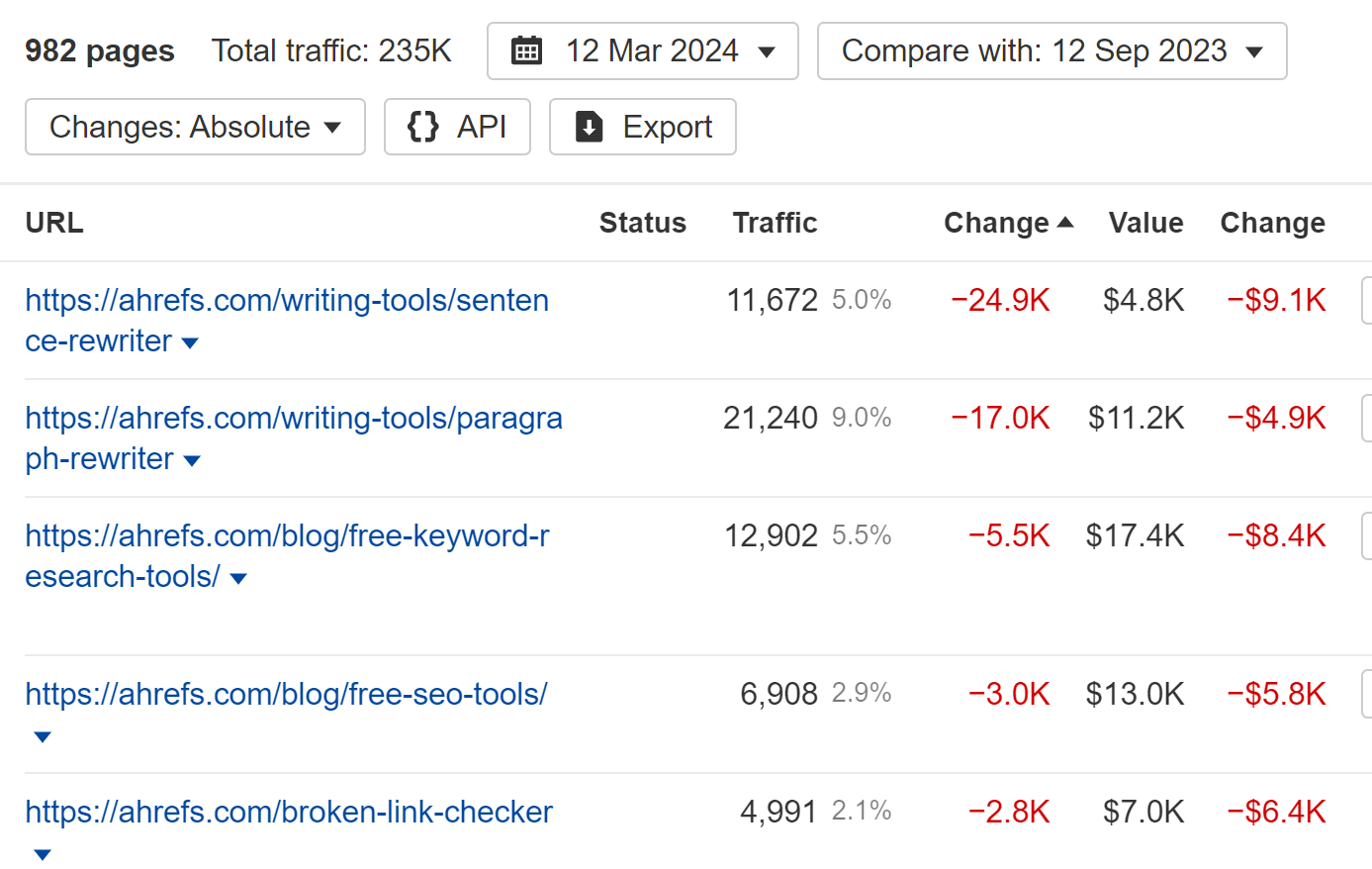

Low-hanging fruit
One common way to prioritize content improvements is to check for low-hanging opportunities, like pages ranking in positions 4-15 for their main keyword. You might be able to quickly improve these pages’ content to rank higher and get more traffic. Use Google Search Console or the Organic Keywords report in Site Explorer to find pages that fit the bill.


Optimize for featured snippets
For informational content, targeting featured snippets can skyrocket you to the top of the SERPs.
Here’s how to find the easiest opportunities:
- Go to Ahrefs’ Site Explorer
- Enter your domain
- Go to the Organic keywords report
- Filter for keywords in positions #1–5
- Filter for keywords that trigger featured snippets “where target doesn’t rank”
- Look for keywords where your page is missing the answer, then add it


This is arguably the most important section that you can write if you want to rank for informational queries. You can see what is already eligible for a snippet and the kind of things that these snippets mention, along with why one may be better than another. Now you just have to make something that’s better.
Here’s an example: For “how to create content,” the main snippet is from inc.com:


If you append “-inc.com” to your search, you’re removing this site from the results and can see the second eligible featured snippet from hubspot.com:
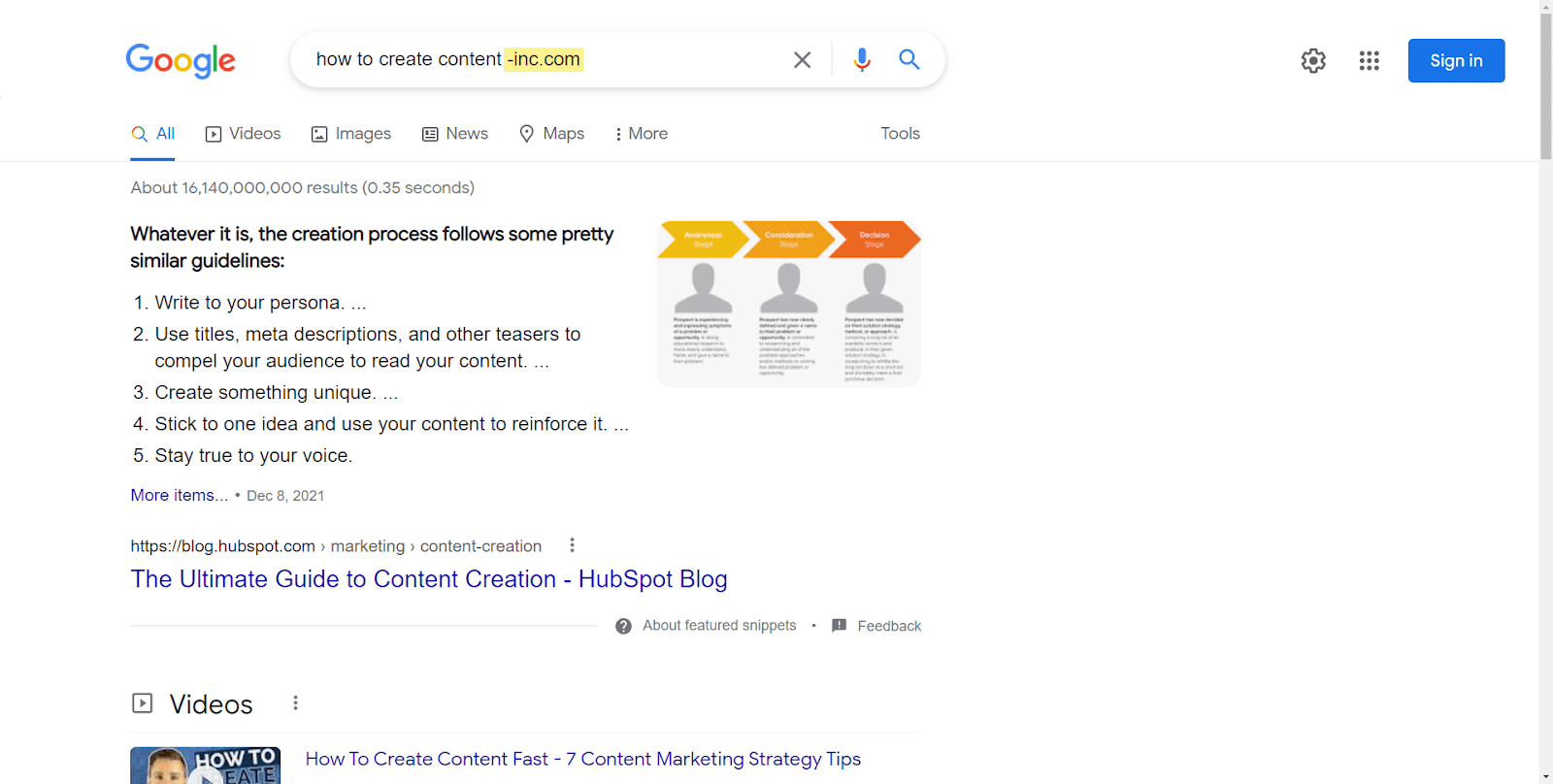

You can repeat this process, removing more sites from the results to see more eligible featured snippets. Also, you can glean insights into what it takes to get featured snippets and figure out why one may be considered better than another.
For some head terms that are more informational in nature, you may have to refine the query as “what is [head term]” for this to work.
Translate successful content
Most enterprise companies operate in many countries and in many different languages, and their enterprise SEO teams will have to work on international SEO. If you have content that’s working well in one language, it’s likely going to work well in another language as well. You should translate successful content for those other languages
We’ve had success with this at Ahrefs despite allocating minimal resources to this process. It’s one of the areas where I expect massive growth as we start to focus on it more.


Create branded content, sometimes
You’re probably going to run into content that is too brand-focused, too product-focused, or even too keyword-focused. People will ask you to rank for terms with pages they control that don’t align with search intent. A good example is someone wanting to “sprinkle some keywords” into their product page to rank for an informational term.
You can use the “Identify intents” feature in Keywords Explorer to show the main intent of each term and the percentage of traffic to each result. A product page for “enterprise content management” isn’t likely to rank for this query as the main pages ranking are informational intent.
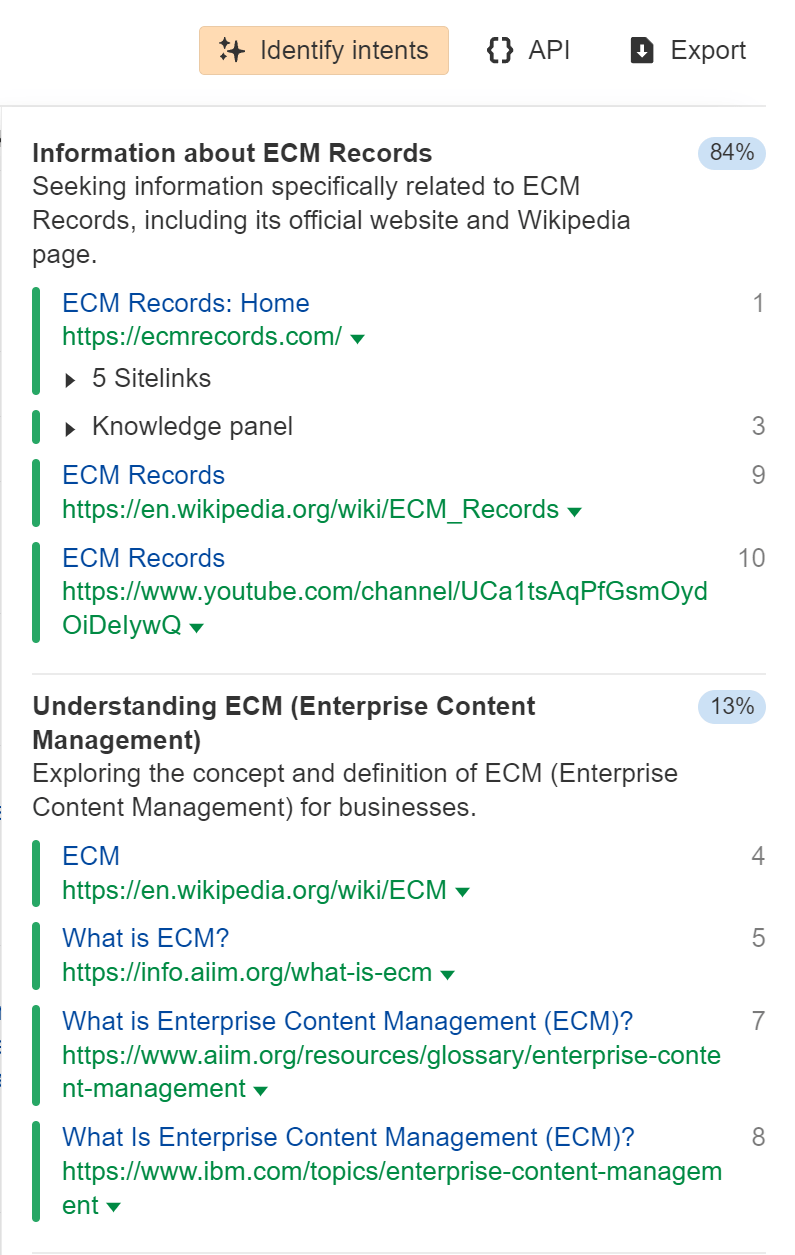

Sometimes, there may be one product page ranking for terms like this where you have a shot at ranking, but it’s usually the most popular product in that position.
There are times you may want to optimize and even create content for branded terms, but this shouldn’t be your usual strategy. Nor should you “sprinkle some keywords” into brand-or-product-focused pages to try to rank for informational terms. These pages may be full of marketing or sales jargon and not have the content you actually need to rank.
Many enterprise websites get a lot of their overall traffic from branded searches, and they may not rank well for unbranded terms. Branded traffic is a good thing. It’s high-quality and converts well, but you should be getting it even without SEO help.
The exceptions to that may be for terms related to companies that were acquired or products that were renamed. You may still need content or documentation to help you keep traffic for those terms and direct people to new versions of the product.
Syndicate content
Content syndication is when one or more third-party sites republish a copy of content that originally appeared elsewhere. It frequently happens with news content, although, to be honest, any popular site is going to have scrapers and enterprise sites may have a paid syndication strategy.
There are a lot of benefits to syndication, including increased reach. Check out our article on content syndication to learn more about it and how to follow best practices.
Redirect relevant old content
In many cases, your old URLs have links from other websites. If they’re not redirected to the current pages, then those links are lost and no longer count for your pages. It’s not too late to do these redirects, and you can quickly reclaim any lost value and help your content rank better.
Here’s how to find those opportunities:
I usually sort this by “Referring domains.”
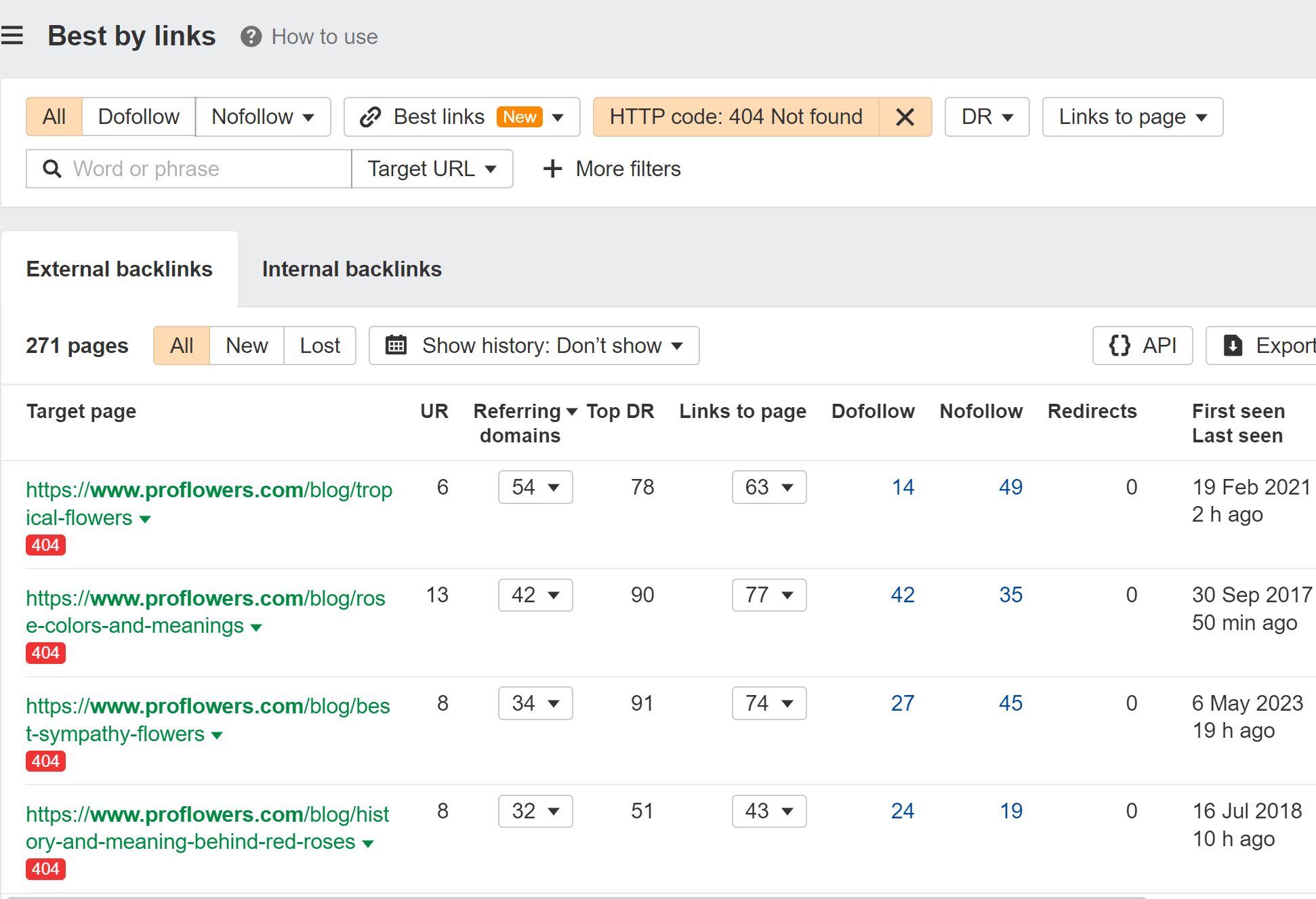

Build and improve internal links
I’ve always found internal links to be a powerful way to help pages rank higher. Even these links may be difficult to get in an enterprise environment.
Sometimes different people are responsible for different sections of the website or even different pages, which can make internal linking time-consuming.
On top of the political hurdles, the process for internal linking can be a bit convoluted. You either have to know the site well and read through various pages looking for link opportunities or follow a process that involves a lot of scraping and crawling to find opportunities.
At Ahrefs, we’ve made this simple, scalable, and accessible so anyone can find these opportunities with our tool in Site Audit. We look at what your pages are ranking for and suggest links from other pages on your site that talk about those things.


I’d also recommend watching out for opportunities to use better link anchor text. It’s common for page creators to overuse generic link anchor text such as “learn more,” “read more,” or “click here.” You can look for usage of this kind of generic copy in the Internal anchors report in Site Explorer.
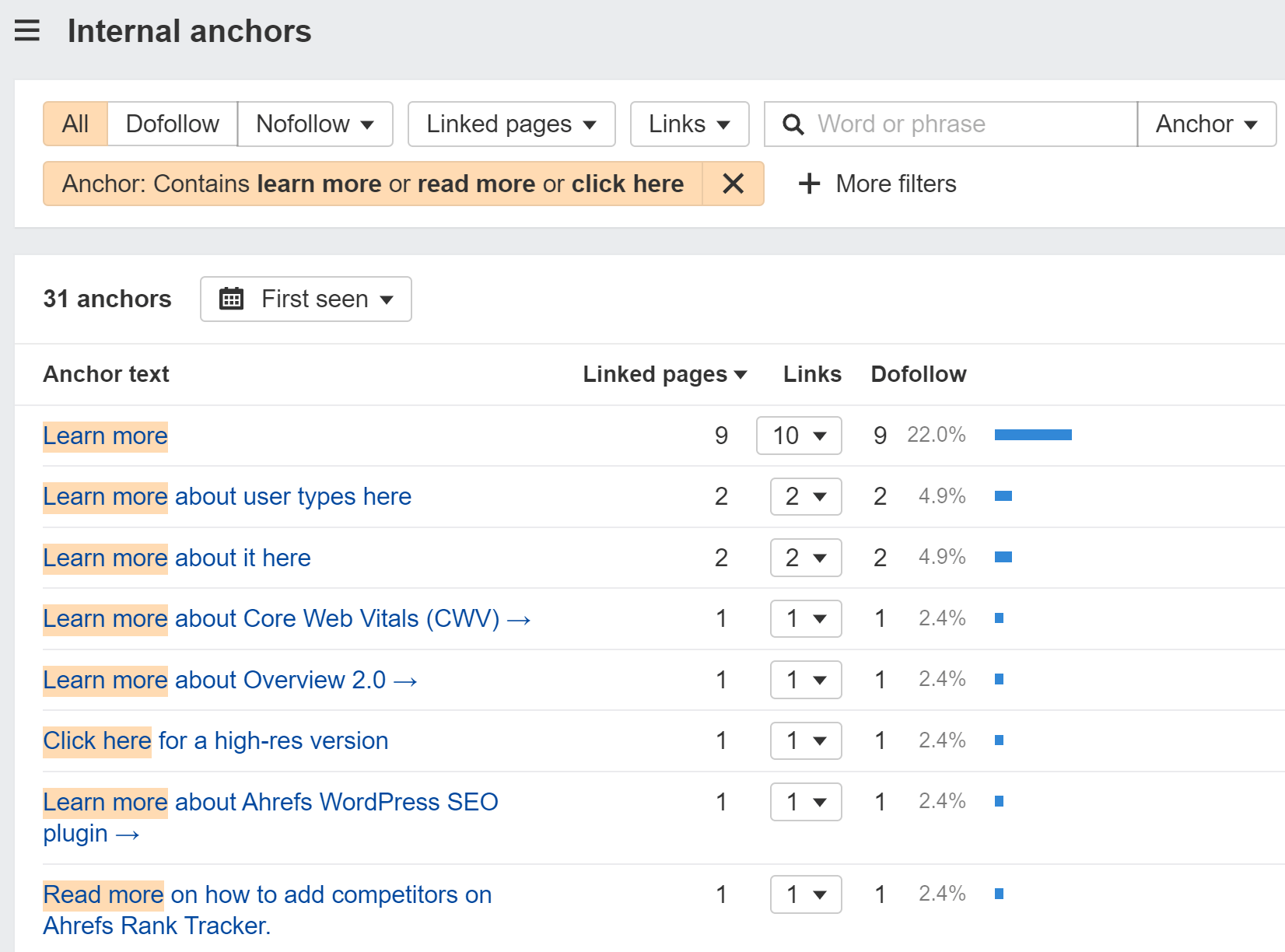

Create “vs” pages
Creating content that compares you against competitors can be difficult to create in an enterprise environment because of all the legal hurdles. I still think it’s useful to push for these kinds of pages so that you can control the narrative.
There are ways you can do this without having giant tables comparing each feature. Those are always biased anyway. For instance, on our vs page, we show what users think of us and talk about the quality of our data and unique features.
This page has done well for us, and I believe we will create more pages like it in the future.
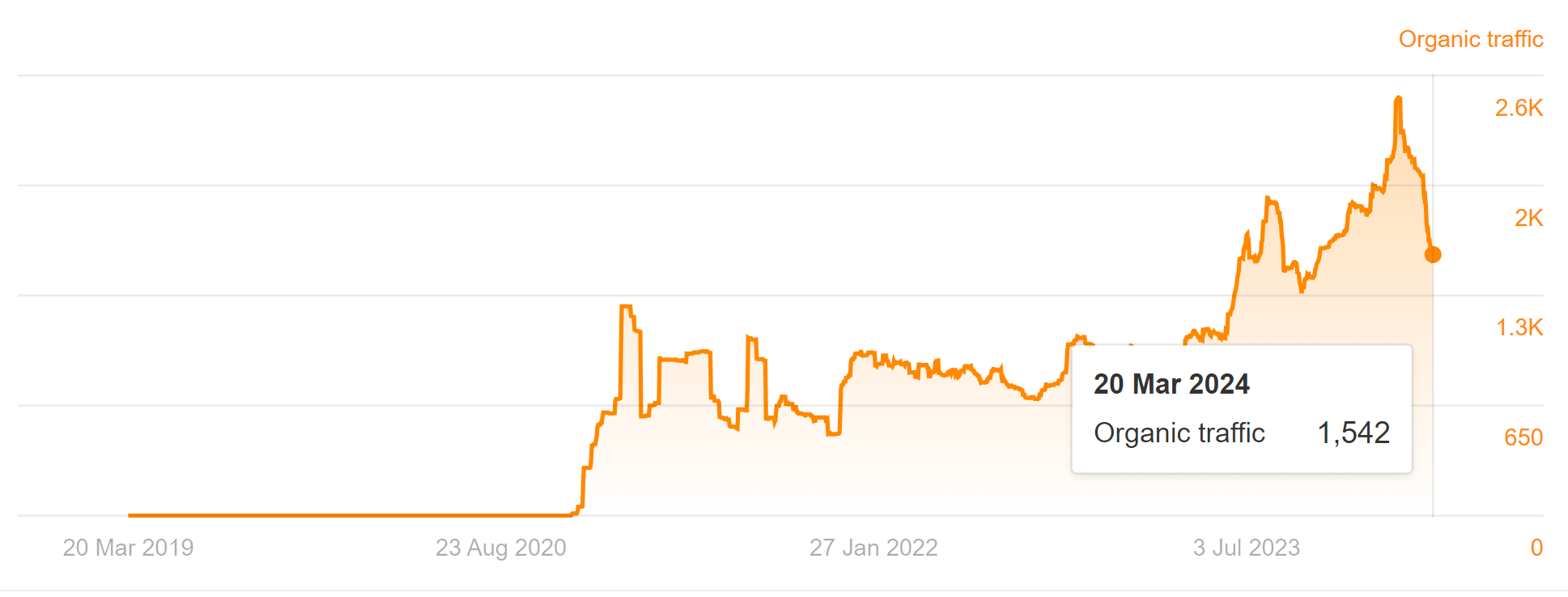

Create free tools
If you can create free tools around your product or data, you can use it as a lead-gen tactic for your main products.
We use this strategy at Ahrefs, and some of our most trafficked pages are from free tools. We even created a bunch of free writing tools, which we are starting to monetize.
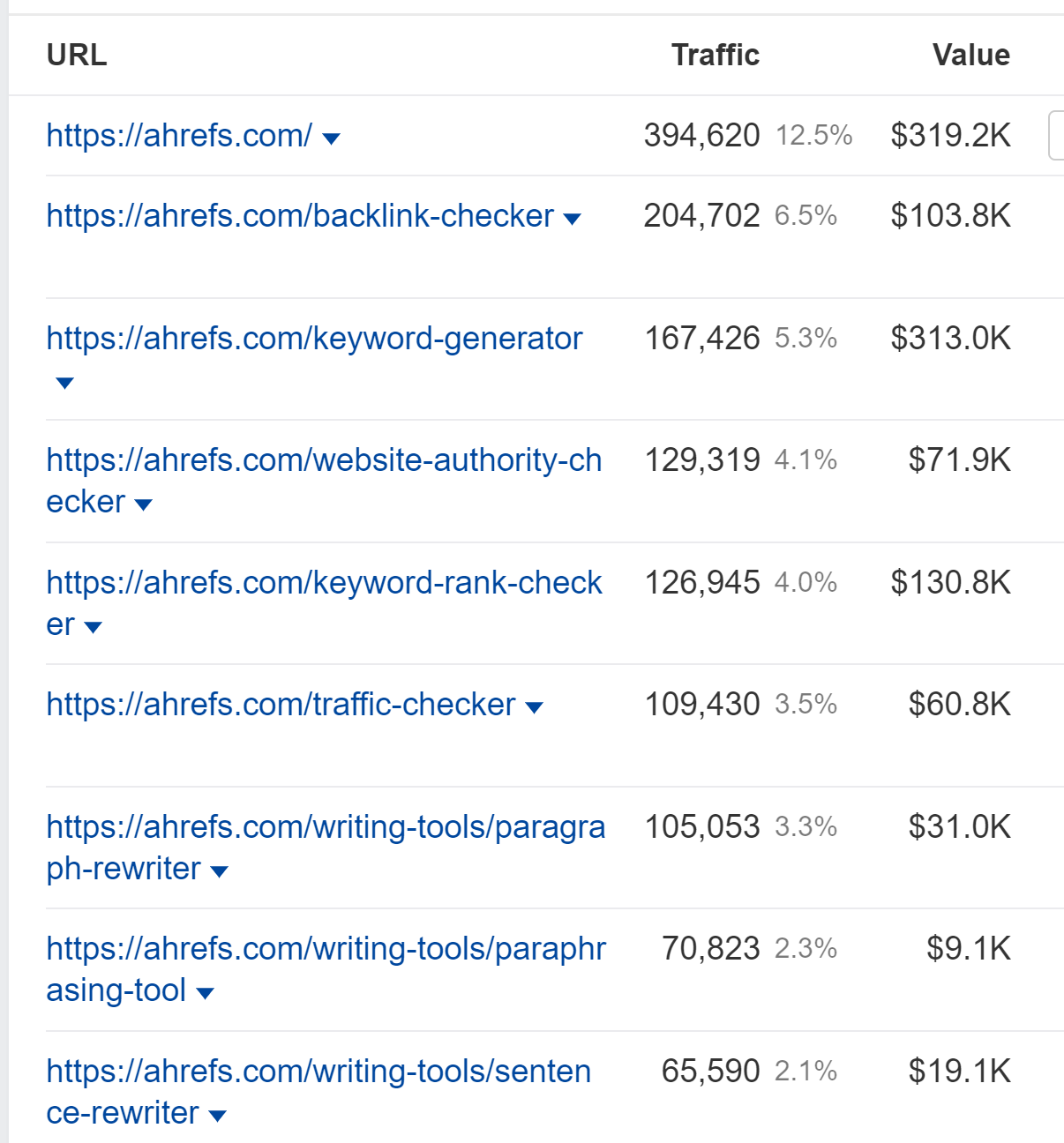

Create programmatic content
If you have the ability to create good pages programmatically using your data, it can be a great way to scale quickly.
We had some success with a small amount of effort by re-using components to create “SEO for x” pages, where x is different types of business. Most of these are ranking well already, but at some point I believe we will put in more effort and pull more data to make these pages even better.
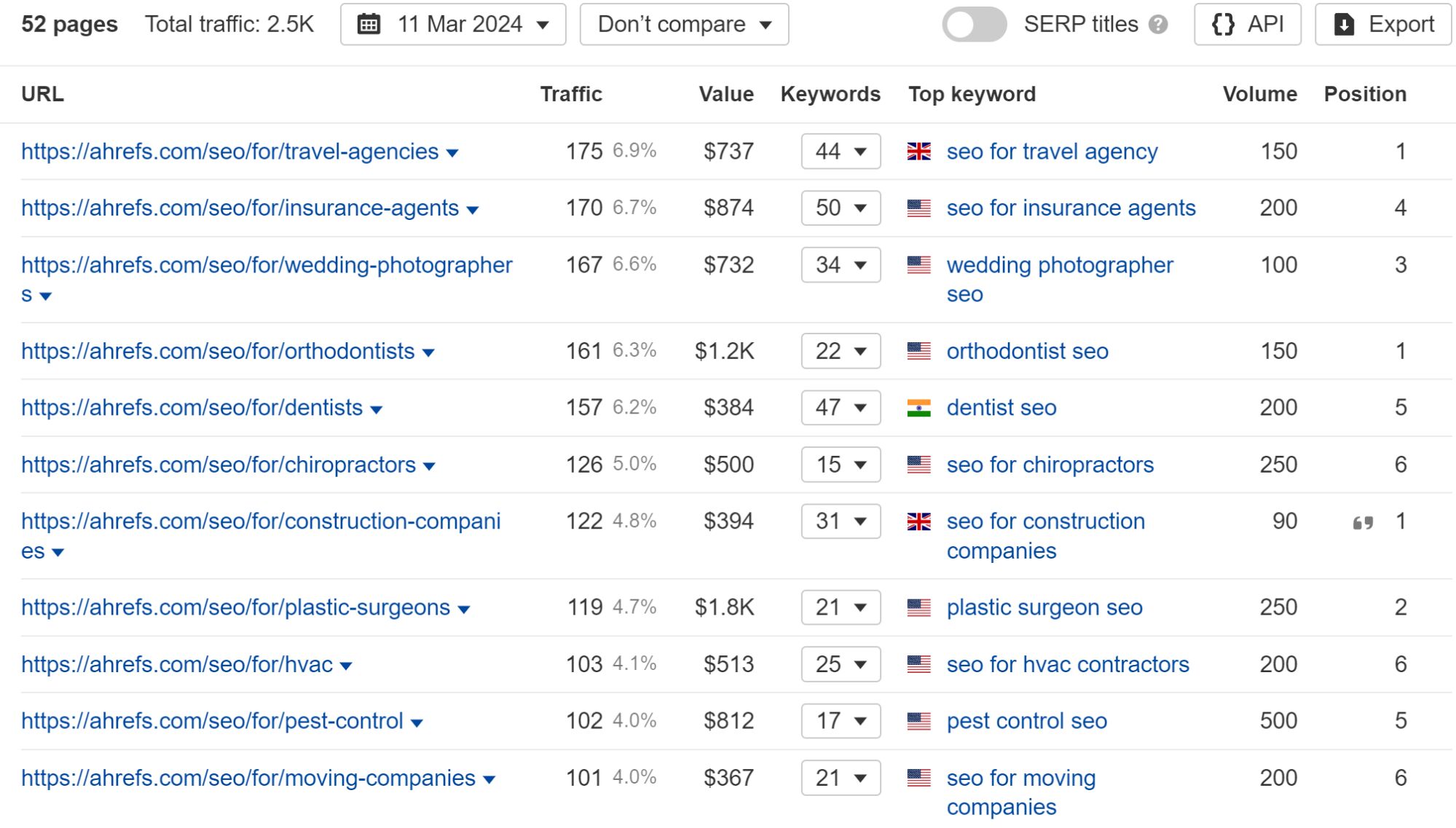

We’re working on some additional programmatic plays that showcase our data even more, and I expect will drive a lot of leads.
Create video content
Video content can work extremely well for businesses. Sam Oh drives tons of leads for Ahrefs.
Ahrefs YouTube has over 500k subscribers with less than 300 published videos. Many of those videos have over 1 million views!
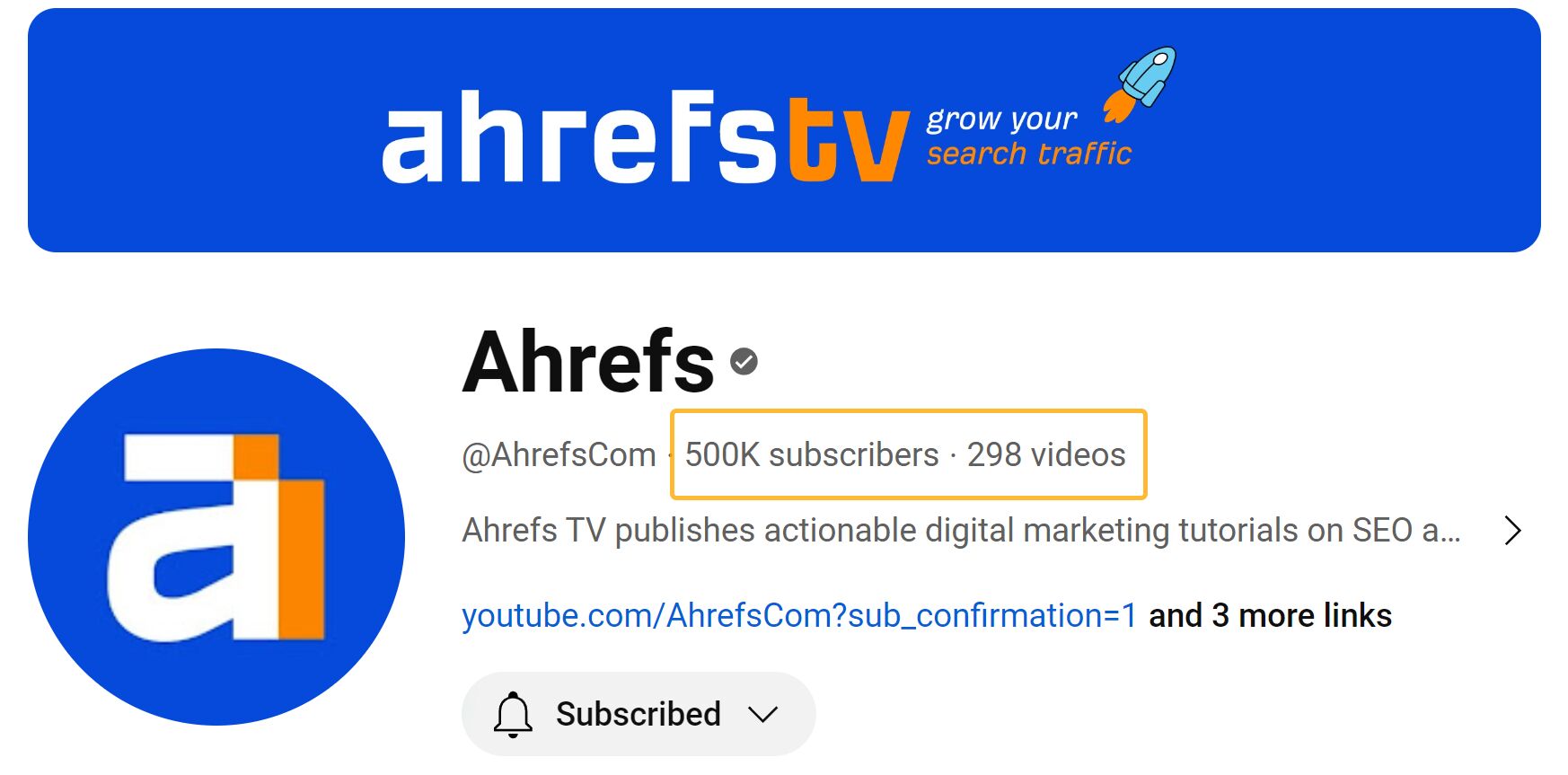

In my past jobs, I’ve always treated videos the same way I would blog content and structured the talking points around the things people are searching for and want to know. This worked extremely well, even for industries where people were convinced that folks in the industry didn’t watch videos.
In enterprise organizations, it can be hard to find your way around, navigate the political landscape, and compete for resources. Don’t expect miracles right away. It can take a while to get traction. Here’s how to make progress.
Show off your successes
After you have some initial success, show that off repeatedly. Do the whole dog and pony show. Eventually, you’ll find advocates for your work and teams who want to work with you to repeat that success. Replicate your success with other teams or business units and show them off, too. Build momentum one win at a time, and eventually most of the organization will be bought in.
Also, try to get involved with any training initiatives the company may have. This way, you can showcase the success you’ve had and educate others on what to do at the same time.
When doing reporting and showcasing wins, try to show revenue generated or as close as you can get to revenue. Revenue, SQLs, MQLS, etc. It’s what executives care about, and you’re more likely to get attention.
Get promoted
As you move up higher in the org chart, it gets easier to make progress. There will be more money available, and it’ll be easier to get buy-in from executives. At a point, things typically start to get centralized, and you may see things like Centers of Excellence (CoE). As standards and processes are written, it’s easier to have everyone follow best practices. This should lead to more success and an easier time getting more buy-in. Every company seems to go through similar transitions in their SEO maturity.
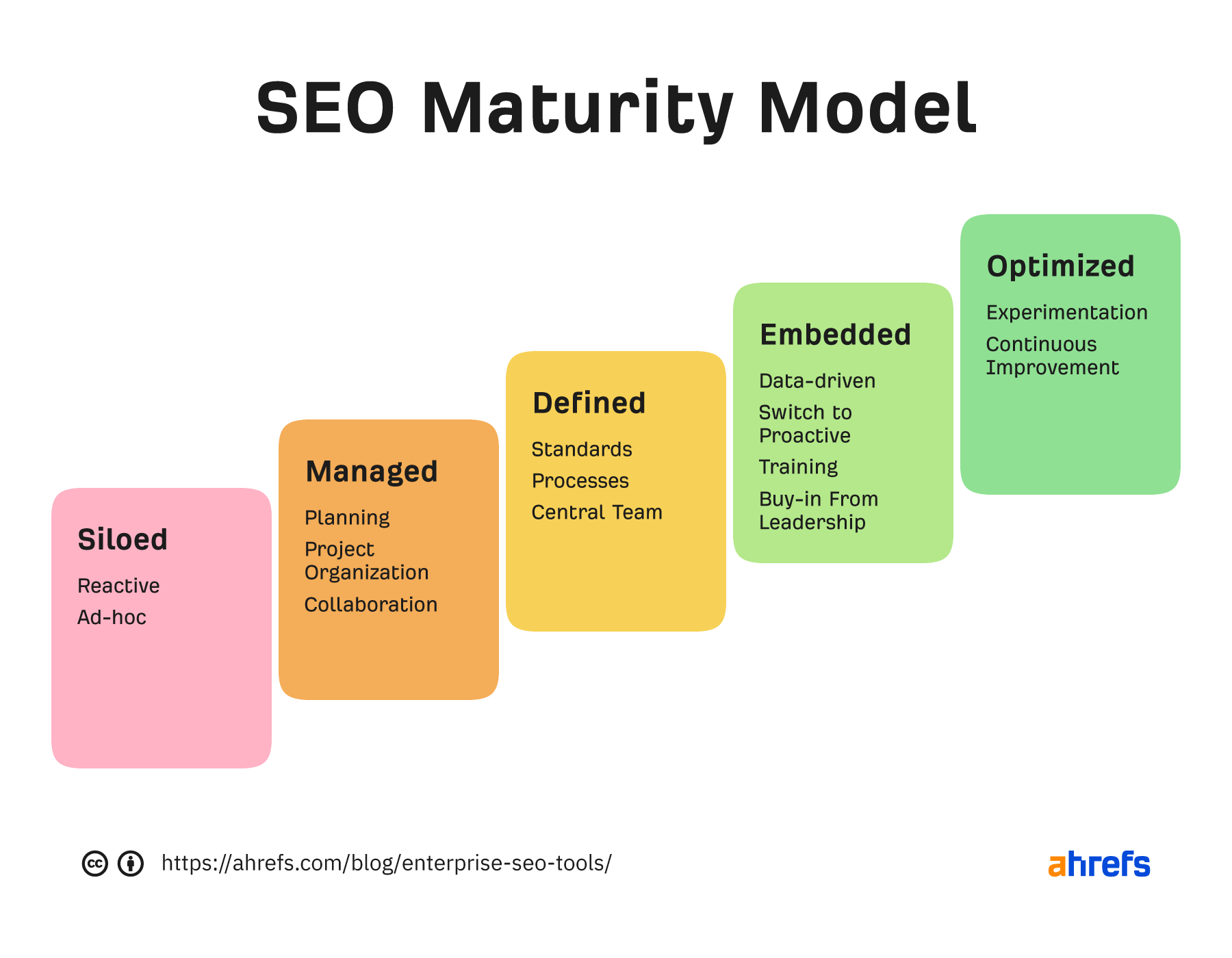

Create enterprise SEO scorecards
Another tactic you can use to get things moving is to create scorecards for different product teams or different business units to showcase how each is improving across different metrics. This can help you identify areas that need additional help or may need some persuasion to get things moving. I describe how to do this in more detail in the Enterprise SEO metrics & reporting article.
Integrate with other teams
One way to get more buy-in is to show people the bigger picture. Communicate with other teams to integrate with them and then show everyone how that leads to more business success.
For instance, the paid team would love to re-market to the people who landed on your organic pages. The social team can help promote your content. If you can show execs the whole picture of how teams can help each other to grow the business, then you’ll get buy-in and resources easier. You can also ask them to help promote your content on their channels.
Align with business goals
It can also help if you can align with business goals. Pushing content around products or services the business wants to grow is a great way to get attention. Many companies have some kind of top 20 / top 50 project where they have specific things they want to push and grow. Start there, get the attention of the folks at the top, and you’ll have an easier time growing your enterprise content marketing program.
Final thoughts
There’s so much at stake in enterprise SEO and so many opportunities. Just keep pushing and building momentum one win at a time. When a company and its people finally get behind SEO, they can dominate an industry.
If you have any tips, enterprise SEO experiences you’d like to share, or questions, let me know on X or LinkedIn.

















